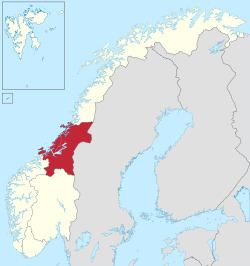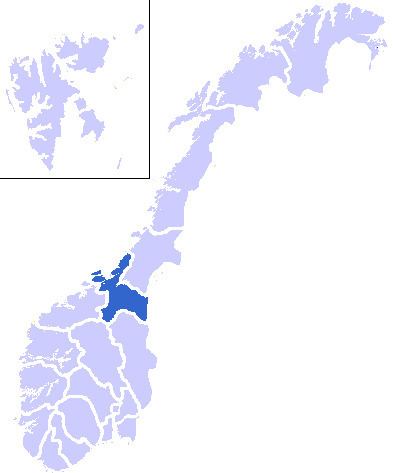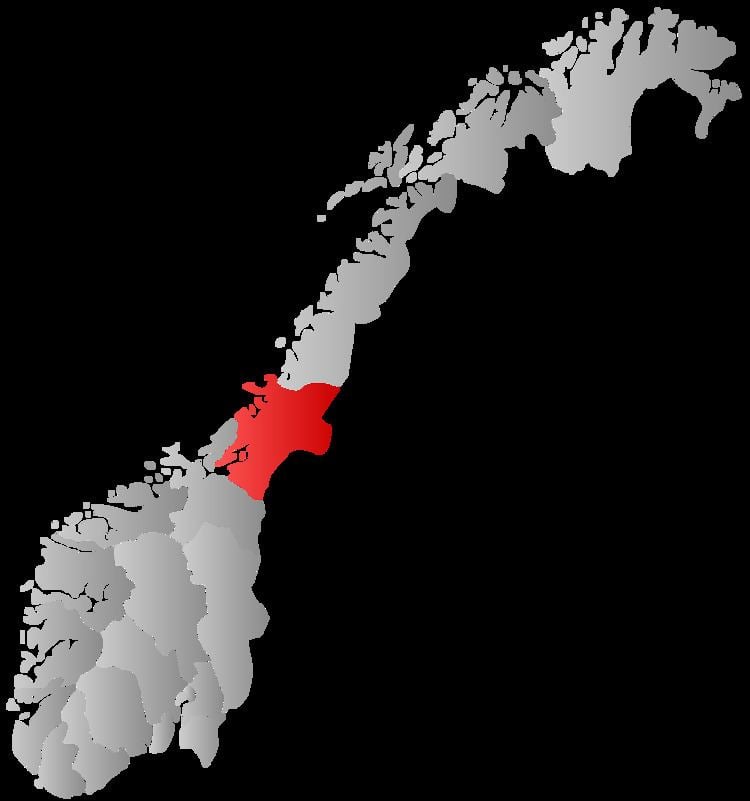Demonym(s) Trønder Nominal GDP per capita (2013) $60,000 Population 418,453 (2009) | Nominal GDP(2013) $25 billion Area 41,260 km² | |
 | ||
Counties(fylker, fylke) Sør-TrøndelagNord-Trøndelag | ||
South coast of tr ndelag kysten av s r tr ndelag
Trøndelag ([²trønːdəˌlɑːɡ]) is a geographical region in the central part of Norway, consisting of the two counties Nord-Trøndelag and Sør-Trøndelag, which will unite again from 1 January 2018. It also formerly also included the county of Jämtland, which is today part of Sweden; it is therefore also known unofficially as Øst-Trøndelag. The districts of Nordmøre and Romsdal, and the municipality of Bindal, were also originally parts of Trøndelag - and the inhabitants there still speak dialects similar to Trøndersk. The region is, together with Møre og Romsdal, part of a larger administrative division called Central Norway.
Contents

A person from Trøndelag is called a Trønder. The largest city, unofficial capital of Trøndelag and also the first capital of Norway, is Trondheim (Sør-Trøndelag). The dialect spoken in the area is characterized by dropping out most vowel endings; see apocope.

The region was divided into two administrative counties in 1804. In 2016, the two county councils voted to merge into a single county in 2018.
The name

The Norse form of the name was Þrœndalǫg. The first element is the genitive plural of þrœndr m "person from Trøndelag", while the second is lǫg (plural of lag n) "law; district/people with a common law" (compare Danelaw, Gulaþingslǫg and Njarðarlǫg). A parallel name for the same district was Þróndheimr, "the homeland (heim) of the þrœndr". Þróndheimr may be older since the first element has a stem form without umlaut.
(See also Trondheim and Trondheimsfjord)
Also see Nidaros to learn more about the name.
History
People have lived in this region for thousands of years. In the early iron-age Trøndelag was divided into several petty kingdoms called fylki. The different fylki had a common law, and an early parliament or thing. It was called Frostating and was held at the Frosta-peninsula. By some this is regarded as the first real democracy.
In the time after Håkon Grjotgardsson (838-900), Trøndelag was ruled by the Jarl of Lade. Lade is located in the eastern part of Trondheim, bordering the Trondheimsfjord. The powerful Jarls of Lade continued to play a very significant political role in Norway up to 1030.
Jarls of Lade (Ladejarl) were:
Trøndelag (together with parts of Møre og Romsdal) was briefly ceded in 1658 to Sweden in the Treaty of Roskilde and was ruled by king Charles X until it was returned to Denmark-Norway after the Treaty of Copenhagen in 1660. During that time, the Swedes conscripted 2,000 men in Trøndelag, forcing young boys down to 15 years of age to join the Swedish armies fighting against Poland and Brandenburg. Charles X feared the Trønders would rise against their Swedish occupiers, and thought it wise to keep a large part of the men away. Only about one third of the men ever returned to their homes; some of them were forced to settle in the then Swedish province of Estonia, as the Swedes thought it would be easier to rule the Trønders there, utilising the ancient maxim of divide and rule.
In the fall of 1718, during the Great Northern War, General Carl Gustaf Armfeldt was ordered by king Charles XII of Sweden to lead a Swedish army of 10,000 men into Trøndelag and take Trondheim. Because of his poor supply lines back to Sweden, Armfeldt's army had to live off the land, causing great suffering to the people of the region. Armfeldt's campaign failed: the defenders of Trondheim succeeded in repelling his siege. After Charles XII was killed in the siege of Fredriksten in south Norway, Armfeldt was ordered back into Sweden. During the ensuing retreat, his 6,000 surviving threadbare and starving Caroleans were caught in a fierce blizzard. Thousands of Caroleans froze to death in the Norwegian mountains, and hundreds more were crippled for life.
Culture
The region's official theatre is Trøndelag Teater, in Trondheim. At Stiklestad in Verdal a historical play, The Saint Olav Drama, has been played each year since 1954, depicting the last days of Saint Olaf .
The region is popularly known for its moonshine homebrew, the karsk. Although officially prohibited, the art of producing as pure home-made spirits as possible still has a strong following in parts of Trøndelag. Traditionally served mixed with coffee, local variations apply. In southern regions, people tend to use normal filter coffee, while in the north they choose to serve karsk with as weak coffee as possible.
The "national dish" of the region is sodd, sheep or beef meat and meatballs in boiled stock. Trøndelag is one of the most fertile regions of Norway, with large agricultural output. The majority of the production ends up in the Norwegian cooperative system for meat and milk, but farm produce is a steadily growing business.
Jazz on a very high level is frequently heard in Trondheim, due to the high-level jazz education in Trondheim. Trondheim is also the national centre of rock music; the popular music museum Rockheim opened there in 2010. Trøndelag is also known for its local variety of rock music, often performed in local dialect, called "trønderrock".
The Norwegian Grey Troender sheep is an endangered breed of domesticated sheep that originated from Trøndelag in the late 19th century. There are currently approximately 50 individual animals remaining and efforts are being made to revive the breed.
